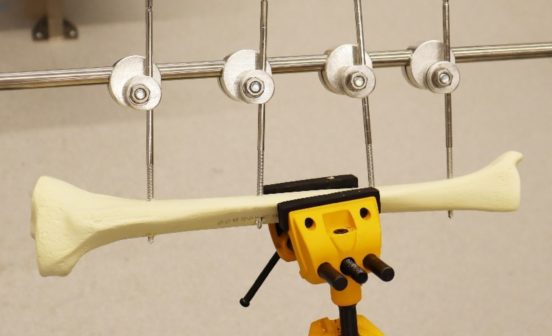DeviceDiagnostic Wearable Full-body Motion Tracking Bodysuit Could Revolutionize the Future of Healthcare

A multi-disciplinary team of researchers has developed a way to monitor the progression of movement disorders using motion capture technology and AI.
In two pioneering studies, published in Nature Medicine, a cross-disciplinary team of AI and clinical researchers have shown that by combining human movement data gathered from wearable tech with a powerful new medical AI technology they are able to identify clear movement patterns, predict future disease progression and significantly increase the efficiency of clinical trials in two very different rare disorders, Duchenne muscular dystrophy (DMD) and Friedreich’s ataxia (FA). The two papers highlight the work of a large collaboration of researchers and experts, across AI technology, engineering, genetics and clinical specialities.
The research was funded by a UKRI Turing AI Fellowship to Professor Faisal, the NIHR Imperial College Biomedical Research Centre (BRC), the MRC London Institute of Medical Sciences, the Duchenne Research Fund, the NIHR Great Ormond Street Hospital (GOSH) BRC, the UCL/UCLH BRC, and the UKRI Medical Research Council.
DMD and FA are rare, degenerative, genetic diseases that affect movement and eventually lead to paralysis with no cures, but researchers hope that these results will significantly speed up the search for new treatments.
Tracking the progression of FA and DMD is normally done through intensive clinical testing. These papers offer a significantly more precise assessment that also increases the accuracy and objectivity of the data collected.
The researchers estimate that using these disease markers means that significantly fewer patients are required to develop a new drug when compared to current methods, particularly important for rare diseases where it can be hard to identify suitable patients.
Scientists hope that as well as using the technology to monitor patients in clinical trials, it could also one day be used to monitor or diagnose a range of common diseases that affect movement behaviour such as dementia, stroke and orthopaedic conditions.
The corresponding author of both papers, Professor Aldo Faisal said, “Our approach gathers huge amounts of data from a person’s full-body movement – more than any neurologist will have the precision or time to observe in a patient. Our AI technology builds a digital twin of the patient and allows us to make unprecedented, precise predictions of how an individual patient’s disease will progress. We believe that the same AI technology working in two very different diseases, shows how promising it is to be applied to many diseases and help us to develop treatments for many more diseases even faster, cheaper and more precisely.”
Movement Fingerprints – the Trials in Detail
Co-author of both studies Professor Richard Festenstein said: “Patients and families often want to know how their disease is progressing, and motion capture technology combined with AI could help to provide this information. We’re hoping that this research has the potential to transform clinical trials in rare movement disorders, as well as improve diagnosis and monitoring for patients above human performance levels.”
In the DMD-focused study, researchers and clinicians at Imperial, Great Ormond Street Hospital and University College London trialled the body-worn sensor suit in 21 children with DMD and 17 healthy age-matched controls. The children wore the sensors while carrying out standard clinical assessments (e.g., the 6-minute walk test) as well as going about their everyday activities like having lunch or playing.
In the FA study, teams at Imperial, the Ataxia Centre, UCL Queen Square Institute of Neurology and the MRC London Institute of Medical Sciences worked with patients to identify key movement patterns and predict genetic markers of disease. FA is the most common inherited ataxia and is caused by an unusually large triplet repeat of DNA, which switches off the FA gene. Using this new AI technology, the team were able to use movement data to accurately predict the ‘switching off’ of the FA gene, measuring how active it was without the need to take any biological samples from patients.
The team were able to administer a rating scale to determine the level of disability of ataxia SARA and functional assessments like walking, hand/arms movements (SCAFI) in 9 FA patients and matching controls. The results of these validated clinical assessments were then compared with the one obtained from using the novel technology on the same patients and controls. The latter shows more sensitivity in predicting disease progression.
In both studies, all the data from the sensors were collected and fed into the AI technology to create individual avatars and analyse movements. This vast data set and powerful computing tool allowed researchers to define key movement fingerprints seen in children with DMD as well as adults with FA, which were different in the control group. Many of these AI-based movement patterns had not been described clinically before in either DMD or FA.
Scientists also discovered that the new AI technique could also significantly improve predictions of how individual patients’ disease would progress over six months compared to current gold-standard assessments. Such a precise prediction allows to run clinical trials more efficiently so that patients can access novel therapies quicker and help with drugs doses more precisely.
Smaller Numbers for Future Clinical Trials
This new way of analysing full-body movement measurements provide clinical teams with clear disease markers and progression predictions. These are invaluable tools during clinical trials to measure the benefits of new treatments.
The new technology could help researchers conduct clinical trials of conditions affecting movement more quickly and accurately. In the DMD study, researchers showed that this new technology could reduce the number of children required to detect if a novel treatment would be working to a quarter of those required with current methods.
Similarly, in the FA study, the researchers showed that they could achieve the same precision with 10 patients instead of over 160. This AI technology is especially powerful when studying rare diseases with smaller patient populations. In addition, the technology allows studying patients across life-changing disease events such as loss of ambulation whereas current clinical trials target either ambulant or non-ambulant patient cohorts.





